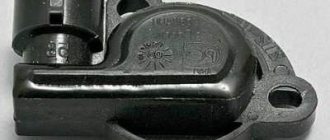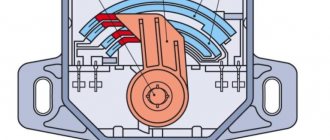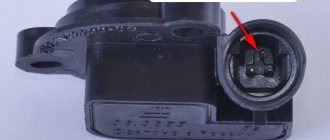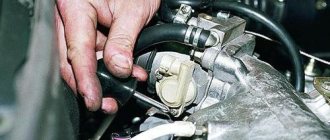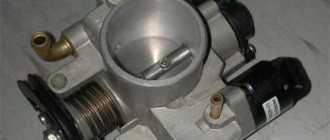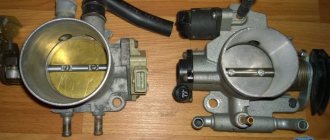Owners of VAZ-2110 cars often have to repair their vehicle. And the consequence of repair work can be both significant breakdowns and minor malfunctions. What type of failure is a malfunction of the throttle position sensor? What is this part responsible for in a car? How can we determine that this particular part is no longer functioning correctly? Read about it in our article.
Evidence of pollution
Let's look at the signs that indicate a malfunctioning throttle valve:
- Revolutions. You sharply release the gas pedal, but the engine is in no hurry to switch to idle speeds from high speeds. Instead of a smooth reset and acceleration, the engine begins to shake, it either stalls completely, or with great difficulty restores the required speed;
- Launch. Your VAZ has difficulty starting cold, and sometimes you cannot quickly start even a hot engine. There may be other reasons for this phenomenon, but the fact that the throttle valve is to blame may be indicated by the fact that after several throttle applications (short-term presses on the gas), the engine usually starts;
- The starter spins for a long time before starting, and the smell of gasoline is heard from the exhaust pipe;
- The engine may run for a couple of minutes after starting.
Dirty throttle valve VAZ 2110
This is interesting: How to remove the steering rack sense
Throttle valve for VAZ 2110
Communities VAZ Repair and Modification Blog Cleaning the throttle valve of the VAZ 2115. Faulty lambda probe oxygen sensor
What is a throttle valve in a car? This is a regulator of the patency of the channel cross-section, which changes the amount of medium, gas or liquid flowing in the channels. It is part of the design of the engine intake system. The throttle valve is an element without which the air will not be adjusted to form a fuel-air mixture, that is, the car will not operate uninterruptedly.
At its core, it is a valve, which is also called a throttle. The design consists of the following elements: the throttle itself is presented in the form of a round plate; it can rotate 90 degrees, that is, at a right angle, fixing the closing and opening of the flow. The body of the device has a complex mechanism, since it is part of the cooling system.
The throttle valves on different types of carburetors are different:
- if the carburetor has a falling current or rapid discharge, then the damper will be in the form of a rigid plate;
- horizontal type carburetor - vertical gate valve;
- in the fuel injection system - represented as a separate unit.
The types of damper drives are: electric, mechanical. It is possible to imagine an electric throttle only in modern car models. Distinctive features characteristic of this type of drive: idle speed is adjustable, there is no mechanics between the damper and the pedal. Thanks to the use of such a drive, it is possible to influence the rotating element without any effort.
To increase the reliability and strength of the element, a module with two sensors is installed. With mechanics, things are completely different. This type of drive is found only in budget cars. There is a connection between the damper and the pedal through a metal cable. We will also warn drivers that if the position of the flap valve and its position sensor is violated, this will entail the following: the speed will fluctuate, the idle speed will increase, the car will stall when the gear is in neutral, and fuel consumption will increase. If a malfunction does occur, a signal on the dashboard will definitely let you know.
To correct this or that problem, you must turn off the ignition, remove the wiring from the sensor, and correct it using a probe. After full adjustment, be sure to check all bolts and nuts to ensure they are securely tightened.
Cleaning Rules
Before removing and cleaning the throttle valve, you need to buy a special cleaner for it. There are many manufacturers, there is enough choice. Among the inexpensive ones, Abro is effective.
Disassembly:
- You need to remove the engine cover (decorative plastic);
- Reduce the pressure in the cooling system by unscrewing the expansion tank cap;
- Loosen the clamps and remove the hose from the forced ventilation air pipe;
- Use a screwdriver to remove the heating hoses for the remote control (it is advisable to plug them for now);
- Disconnect the cable and unscrew the fastening nuts. Now removal of the throttle assembly is possible;
- Use a cleaner to wash everything very thoroughly. Most often, it is necessary to use a needle to check whether the forced ventilation channel is coked, and also to clean it;
- Cleaning is necessary for the idle air regulator, for which it must be removed and inspected. If you find that it is jamming and adjustment is impossible, then it needs replacement;
- After washing, reassemble everything as it was. Please make sure that the gasket is intact and in good condition, then you can leave it. If this is not the case, then only replacement.
Signs of a malfunctioning throttle sensor on a VAZ 2110. Our list
- Floating idle speed until the engine stops in neutral;
- Jerks during acceleration, the car jerks and accelerates extremely difficult;
- The Check Engine light is on.
- To do this, turn on the ignition and measure the voltage at the TPS terminals, it should not exceed 0.7 V;
- Next, use the plastic sector to fully open the throttle. Then the voltage is measured again. The normal value is at least 4B;
- Then check the correct operation of the sensor. To do this, you need to measure the voltage at the TPS terminals when the damper moves.
- It should not jump sharply, all changes should occur smoothly. Abrupt changes indicate a malfunction of the device;
- The final check is to check the resistance between any of the terminals and the slider contact. To do this, turn off the ignition and pull out the connector. When turning the damper, this indicator should change evenly.
AutoFlit.ru
Symptoms of sensor malfunction
The main control unit contains a program: if one of the important meters stops working, the air-fuel mixture is prepared and supplied according to average indicators, and the Check Engine warning sign turns on on the dashboard. Emergency operation with increased fuel consumption is a clear sign of a breakdown of any sensor.
The insidiousness of the TPS is that it does not break in the usual sense. When the resistive film begins to wear away, the resistance of the device changes unpredictably. The controller either “sees” a working sensor in the circuit, or notes incorrect voltage surges and tries to switch to emergency mode. From here, the main sign of a malfunctioning throttle valve is determined - a periodically flashing Check Engine display.
The problem is accompanied by a change in the behavior of the engine, or more precisely:
- “shaking” and spontaneous stops of the engine idling;
- there is no acceleration dynamics; after pressing the gas pedal, jerks and dips are observed;
- increased idle speed of the power unit (1500–2500 rpm);
- the car “does not pull” due to loss of power;
- jerks are also felt while driving;
- Fuel consumption increases by 10–25%!
The listed symptoms can be caused by a dozen reasons, ranging from malfunctions of the ignition system to wear and tear of engine parts. That is why it is important to weed out problems that lie on the surface, including incorrect operation of the throttle position sensor.
Purpose of the sensor
The sensor is designed to determine the angle at which the throttle valve has opened. The sensor transmits the received data to the engine control unit, which processes this signal.
Resistor TPS
Resistor TPS
The principle of operation of the sensor is based on a conventional electrical resistor, which, when rotated around its axis, changes the resistance. The data sent to the ECU is based on resistance. This operating principle reduces the cost of producing the sensor, but affects its durability. With this design, the working part of the sensor, namely its tracks, frays quite quickly, which leads to loss of conductivity and, consequently, to sensor malfunction.
The advantage of this sensor is its low price, but due to its rapid breakdown it is not justified.
Non-contact TPS
Non-contact TPS
There is another type of sensor - non-contact. As a rule, such a sensor costs much more, but its durability is several times higher than that of a standard sensor.
It is recommended to purchase a non-contact sensor, as it has more advantages and is more durable in comparison with a resistor TPS.
How to choose the right TPS? Which sensor is better to buy?
Film-resistive throttle position sensors are the most popular among motorists, this is explained by their low cost, but the service life of such sensors also leaves much to be desired. I recommend buying contactless TPD VAZ 2110, the price of such a device is higher, but thanks to the magnetoresistive operating principle it can boast an excellent service life.
Current:
- How to check the coolant temperature sensor (DTOZH) VAZ 2114
- How to check the VAZ 2109 starter at home
- Diagnostics of faults of the VAZ 2110 mass air flow sensor and its replacement
How to get rid of moving parts
If it turns out that the TPS is faulty, then it is advisable not to skimp and install a contactless sensor when replacing it. Its main element is a Hall sensor, very reliable, with no moving parts at all. It records with great accuracy all changes in the magnetic field when the throttle angle changes and transmits it to its own electronic circuit. When replacing the sensor, no changes to the design need to be made. It is enough to simply dismantle the old one and install a new TPS.
Communication of the throttle valve with other automotive systems of the VAZ-2110
The throttle valve of a VAZ-2110 car is a component of the engine intake system and is directly connected to a large number of other vehicle systems. These include the following systems:
- directional stability;
- anti-blocking;
- anti-slip;
- anti-slip;
- cruise control.
In addition, there are those systems that are controlled by the electronics of the gearbox. After all, it is this throttle valve that regulates the flow of air into the car system and is responsible for the quality composition of the fuel-air mixture.
This is interesting: How to remove a tie rod without a puller
What is TPS in a VAZ-2110 car?
The throttle position sensor is abbreviated as TPS among motorists. This part is used in several types of engines:
- Gasoline injection type.
- Single injection type.
- Diesel engines.
TPS is also known as a throttle valve potentiometer. This is due to the fact that the sensor is designed to function as a variable resistor. The sensor itself is installed in the engine compartment - the place of fixation is the throttle pipe. The mechanism of operation of the sensor is as follows: depending on the position and degree of opening of the throttle valve, the resistance also changes. That is, the level of the value of such resistance depends on the pressing of the gas pedal. If the pedal is not pressed, the throttle valve will be closed and the resistance will be minimal. The opposite is true when the damper is open. Accordingly, the voltage across the TPS, which is directly proportional to the resistance, will also change.
The control of such changes is carried out by the electronic control system; it is the one that receives all signals from the TPS and supplies fuel using the fuel system.
So, at the maximum voltage of the signal contact of the throttle position sensor, the fuel system of the VAZ-2110 car will supply the largest portion of fuel.
Thus, the more accurate the TPS indicators, the better the VAZ-2110 electronic system adjusts the engine to the correct operating mode.
What is TPS and where is it located?
The damper position sensor is a car potentiometer, one end of which is connected to ground, the other to the positive voltage. It also has a third contact; it sends signals about the throttle position to the vehicle's electronic control unit.
The throttle sensor on a VAZ 2110 car operates on a very simple principle: the throttle opens the throttle at the moment when the driver presses the accelerator pedal. This leads to increased tension. Based on this change in voltage, the TPS adjusts the quality and parameters of the combustible mixture. The relationship is similar when the driver releases the gas pedal.
The VAZ 2110 throttle position sensor is located in the throttle body.
It is not difficult to get to it, so if it is necessary to replace this device, a more or less competent driver can dismantle the TPS and install a new sensor independently, without going to a service station.
Operating principle of TPS
Throttle position sensors are divided into two types: contact and non-contact. They are different in design, but the methods for testing them are the same. Their drive can be mechanical or electrical.
The first mechanical ones (film resistive or potentiometers) are a slider with contacts placed on it.
The throttle valve, through the drive and gear with the shaft, changing its position (angle of inclination) moves the slider along the resistor tracks. Based on the voltage from 0.7 to 4V (varies due to changes in the resistance of the resistor tracks), the ECU understands where the damper is located and adjusts the fuel supply.
Those. increasing the angular position of the damper increases the DC voltage value and vice versa.
When the driver just turns on the ignition, the ECU receives data from temperature sensors about the degree of engine warming up. Based on this, the throttle valve is set to the pre-start position at a certain angle.
For example, on the Lada Priora and Kalina, where there are two TPS (in cars with an electronic throttle pipe module), at this moment the output signal voltage should be:
- The first output is in the range of 0.39-0.52V.
- The second is 2.78-2.91V.
For each car brand, these indicators may differ, but if we consider the above models, then the following happens:
- If after turning on the ignition within 15 s. nothing happens (the gas pedal is not depressed, the engine does not start), the ECU turns off the electric throttle drive, and the throttle drops to 7%.
- 30 seconds after the ignition is turned on and the driver is inactive, the ECU closes the damper completely and then returns it to the pre-start position.
In this case, the signal output voltage is equal to:
- In the first case, 0.5-0.6V.
- In the second - 2.7-2.8V.
If there is a break in the throttle sensor circuit, the ECU turns off the throttle drive and stores an error code in the memory.
Also, on cars with two TPS, as is the case with Lada Priora and Kalina, their total signal output voltage should not exceed 3.2-3.4V.
The operating principle of non-contact (magnetoresistive TPS) is based on the magnetic-resistive effect - they rarely fail, due to the absence of contacts rubbing against each other. For this reason, they are more reliable and last longer, although they are more expensive than contact ones.
Common causes of malfunction are short circuits in electrical circuits, broken wiring.
Characteristic symptoms of a malfunctioning TPS condition
Thanks to the correct functioning of the throttle position sensor, the fuel system of the VAZ-2110 car engine works with a smoothing effect. That is, the vehicle moves smoothly, and the gas pedal responds well to pressure. Therefore, a malfunction of the TPS can be noticed almost immediately by the following signs:
- Poor engine starting.
- Noticeable increase in fuel consumption.
- The car's movements are intermittent.
- The idle speed of the engine is noticeable when running.
- The Check e light comes on on the dashboard
- The car accelerates poorly due to delays in acceleration.
- Popping sounds are heard in the intake manifold.
Of course, these signs of a faulty sensor may not all be observed at once. But even if you notice only one of the above symptoms, it is worth carrying out computer diagnostics of the vehicle at a service center.
TPS design
The throttle position sensor can be of two types:
- film;
- magnetic or contactless.
In its design, it resembles an air valve - in the open position the pressure corresponds to atmospheric pressure, in the closed position it drops to a vacuum state. The TPS includes DC and AC resistors (each resistance is 8 ohms). The process of opening and closing the damper is monitored by the controller, with subsequent adjustment of the fuel supply.
If at least one symptom of a malfunction occurs in the functioning system of this sensor, then fuel may be supplied to the engine either in excess or in deficiency. Such malfunctions in engine operation are reflected in the engine of the VAZ-2110 car and on its gearbox.
TPS problems and their diagnosis
As you know, eternal parts for cars have not yet been invented. And the breakdown of the TPS can be foreseen; for this you need to inquire about the possible reasons for the failure of this part. Here are the main ones:
- Abrasion of the sprayed base layer, which serves to move the slider (the result is incorrect TPS readings).
- Failure of the movable type core (the result is deterioration of the contacts between the slider and the resistive layer).
How can you figure out problems with this sensor yourself? To do this, you can independently diagnose the operation of your diagnostics:
- Listen to the VAZ-2110 engine idling: the breakdown is obvious if you notice that its speed is in a “floating” state;
- a malfunction is present if the engine stops after this action.
- There is a problem with the TPS if the car starts to move jerkily, which indicates an incorrect supply of fuel to the system.
Experts say that most often the sensor fails when the resistive track is heavily contaminated or is completely broken. To verify the opposite, you need to check the working condition of the TPS.
Malfunctions
There are several telltale signs of trouble that may indicate that there is a problem with the throttle valve control.
- High idle speed;
- When the gear is switched off, the engine may stall;
- When the car picks up speed, the car jerks and jerks are felt;
- Acceleration dynamics deteriorate significantly;
- Floating speed occurs at idle.
It should be noted that similar symptoms may also be characteristic of the failure of other components - the idle speed control or the ignition module, for example. Therefore, you first need to check the TPS.
Checking the status of the regulator
Next, let's talk about how you can check this throttle valve sensor. The event is necessary because it allows you to understand whether all the troubles are really due to it, or whether the problems arose due to the failure of other elements of your car.
It’s not uncommon for novice car owners to make hasty conclusions based on the primary signs of a breakdown. This results in unnecessary repair work and costs.
To check the current status of the throttle position sensor you need to:
- Measure the voltage at the output of the slider, turning on the ignition and opening the idle contacts;
- If the test shows that the voltage is more than 0.7 volts, then the sensor has indeed failed;
- Open the damper completely. In normal condition, voltage readings should be no more than 4 volts;
- Measure the variable resistor for resistance;
- To do this, connect an ohmmeter or a multimeter in ohmmeter mode to the power supply and output;
- Slowly begin to turn the throttle;
- At the same time, monitor the readings on the device;
- If, as the damper opens, the resistance also changes slowly, then the unit is working properly.
If you find during the test that the sensor is faulty, you only need to replace it. It cannot be repaired.
The resistive layer along which the slider moves wears off over time due to friction. Because of this, the regulator begins to produce incorrect data, the characteristics of the supplied mixture change, and engine performance deteriorates.
Disabling the regulator
Replacement
In fact, changing this sensor is insanely easy. So don't rush to send your car to a service station. Everything can be done with your own hands, the quality will not suffer from this.
- To remove the throttle position sensor, you first need to find it.
- As we have already noted, the desired unit is located on the side of the throttle pipe on the throttle valve axis.
- Having found the element, pick up a shaped screwdriver.
- Using this simple tool, unscrew a couple of bolts that hold the device.
- Pay special attention to the gasket that is available under the old regulator. We do not recommend using it again; it is better to immediately buy a new one. Often the gasket is already included with the throttle sensor itself.
- After removing the old sensor, you can slightly clean the place where it is installed if there is dirt there.
- Next, a new sensor is installed along with a new foam gasket and the bolts are tightened.
- Try to tighten the fasteners as far as possible, otherwise the new throttle sensor will quickly lose its effectiveness. The work will have to be done again.
- There is no need to make any adjustments after replacement.
- The zero mark on the controller will determine that the throttle is completely closed.
Foam pad
What to choose?
When replacing, many more or less experienced car owners have a question about which regulator is better to install. After all, there are two types.
| Sensor type | Peculiarities |
| Film-resistive | These sensors are usually factory installed. The service life of such a throttle position sensor is stated to be about 55 thousand kilometers, but in practice it has to be changed more often |
| Contactless | The operation of such a device is based on the magnetic-resistive phenomenon; a Hall element is used. The cost is noticeably higher than the first option, but it is unlikely to have to be changed. Huge resource, high reliability |
In pursuit of savings, many forget about the importance of quality. But it should be in the first place when choosing spare parts when repairing a car.
TPS is an important, but easy to replace device. The repair operation will take you no more than an hour, even if you are just beginning to learn the joys of repairing your car yourself.
But under no circumstances delay repairing the sensor, otherwise this may negatively affect the operation of the engine, its service life and the cost of fuel, which you will overuse due to incorrect data from the sensor to the ECU.
Purpose of TPS
The throttle valve device is designed to detect the current throttle position. Based on this, the fuel mixture supply mechanism exchanges the amount of fuel supplied during a certain operating mode of the power device.
If you have questions about this device, it makes sense to contact a service station to avoid loss of nerves and strength. However, it is worth noting that in practice, replacing the TPS with your own hands is not as difficult as it seems, and everyone will be happy to save extra money.
The desired controller is located on the side of the throttle pipe on the damper axis.
Procedure for replacing TPS
We turn off the “ground” using the corresponding button or simply remove the negative terminal from the battery. Very carefully press the plastic latch on the sensor, and then disconnect the wiring connected to the TPS. Now we need a shaped screwdriver, with which we need to unscrew the fastening screws (there are two of them). Installing a new sensor is carried out, as you yourself understand, in the reverse order.
Here I would like to add that two types of sensors are currently sold - film-resistive and non-contact. Film ones are characterized by an operational life of about 50 thousand kilometers; they are, as a rule, installed on cars initially (at the factory). Contactless devices equipped with a Hall element are considered by experts to be of higher quality. The resource of their use is almost unlimited due to the fact that they operate on the magnetoresistive principle.
But be prepared to pay quite a lot of money for a contactless sensor. Compared to film elements, they are really expensive. When installing a new sensor, tighten the mounting bolts very carefully. If the tightening is not sufficient, the device will break quite quickly. In addition, do not forget to install a new foam rubber gasket instead of the one that was previously available on the TPS.
(1 vote, average: 5 out of 5)
Home →
Device →
Fuel and exhaust systems →
Fuel injection system →
Procedure for replacing the sensor
To get the job done, you only need a medium sized screwdriver. The sequence of actions is as follows:
- Disconnect the block with wires from the sensor.
- Unscrew the two mounting screws.
- Remove the sensor.
- Replace the foam pad.
- Install a new sensor.
- Connect the electrical block.
Thus, replacing the TPS yourself does not pose any problem, although there is one “but”. The sensor is tested by the vehicle's on-board computer. In the event of a malfunction, the “Check engine” is turned on. So, even after installing a new TPS, the alarm will not go off. You will have to disconnect the battery terminal for 15 minutes or reset the error in another available way.
Location and principle of operation of the meter
The sensor is installed on the throttle valve block and is mechanically connected to its axis. Thanks to this, the device is able to solve 3 problems:
- inform the controller at what angle the throttle is currently open;
- signal that the air supply is completely closed (the driver has released the accelerator pedal);
- monitor the speed at which the damper opens.
Based on this information, the electronic powertrain control unit (ECU) makes a decision to increase or decrease the fuel supply and fuel injection for intense acceleration when the gas pedal is sharply pressed.
Reference. Two types of TPS are installed on cars: resistive and non-contact. The first ones are cheaper and therefore are found on all budget cars. The latter are more reliable and more expensive, and are installed on cars of medium and high price categories.
The operating algorithm of the resistive sensor is as follows:
- At idle, the damper is closed and air flows into the engine through a separate channel. The voltage at the output of the device does not exceed 0.5 volts; the controller supplies fuel to maintain engine idle speed.
- When the driver presses the gas pedal, the sensor slider moves along the resistive film. The resistance of the electrical circuit into which the device is connected in series decreases.
- The ECU “sees” the increase in voltage in the meter circuit, makes a calculation, prepares the air-fuel mixture in the required quantity and supplies it to the cylinders. The maximum voltage at wide open throttle is about 4.5 V.
- When the driver sharply presses the accelerator pedal, the controller notes a similar voltage surge and delivers a portion of the enriched mixture for dynamic acceleration.
Note. The operating voltage values are indicated for a common Russian car - VAZ 2110.
The non-contact throttle position sensor functions identically. The difference lies in the method of influencing the electrical circuit. A resistive device changes resistance using a slider moving across the film, while a non-contact device changes resistance due to the magnetic-resistive effect. Thanks to this principle of operation, the TPS lasts much longer and does not create problems for the owner of the car.
Detection methods
The most basic way to check is to immediately replace the suspected sensor with a new, working sample. If the car's performance improves, then the reason is clear. Remains at the same level, conclusion: some other part has failed.
There is a method of checking without dismantling the sensor using electrical measuring instruments.
Carrying out this procedure independently by an ordinary car enthusiast is only possible if he has the skills to use a multimeter. The first measurements of the electrical voltage are made with the throttle valve closed and the engine ignition on. The contacts of the idle speed sensor will need to be opened during measurements.
One probe is installed on ground, the other on the moving contact. The voltage value should be close to 0.7V. Then the throttle valve is opened as much as possible by pressing the gas pedal and the measurements are repeated. In the second case, the device readings should not exceed 4V. If the digital data corresponds to the norm, it is advisable to duplicate the test by measuring the resistance value by switching the multimeter to ohmmeter mode.
The wire plug will need to be disconnected. One probe is installed on the power supply contact, the second on the output. When you smoothly press the gas pedal, the indicators of the device should also change evenly. To do this, it is convenient to use a multimeter with an arrow. The smoothness of its movement will be more obvious. Jerks and fluctuations confirm that the device being tested is damaged. This means that the resistive layer has worn off or its contact with the slider has deteriorated.
Why is it needed?
The throttle position sensor is responsible for determining the current throttle position. Depending on this, the fuel supply system changes the amount of fuel supplied under one or another operating mode of the power unit.
If problems arise with it, you can contact a service station so as not to waste your energy and nerves. But in practice, changing the TPS yourself is quite simple, plus you will save a decent amount of money.
The desired regulator is located on the side of the throttle pipe on the throttle valve axis.
Regulator location
Checking the operation of the throttle position sensor
To check the TPS yourself, it is not necessary to call an auto electrician for consultation. To do this you need a multimeter or voltmeter. Next, experts offer step-by-step instructions for checking the sensor.
The first step is to turn the key in the ignition switch, take the voltage readings between the sensor slider contact and the minus. In normal condition, the indicator will be up to 0.7 V.
The second step is to turn the plastic sector and open the damper, and then take measurements again. In the normal state of the sensor, the device will show a result of 4 V.
Why did the VAZ TPS fail?
- The most common cause of failure is the disappearance of the base coating at the beginning of the slider stroke. As a result of this phenomenon, a linear increase in the output signal voltage does not occur.
- The second possible cause of a faulty throttle position sensor is a failed moving core. Damage to one of the tips can result in scuff marks on the substrate, after which the remaining tips fail. The contact between the resistive layer and the slider disappears.
Idle speed regulator VAZ 2110, device and principle of operation
If in a carburetor engine the idle speed system was responsible for the operation of the engine at idle, then in an injection engine it was the regulator. It consists of:
- housings;
- stepper electric motor;
- lead screw;
- cone valve;
- electrical terminals.
Video repair of idle speed and main faults
The device is installed behind the throttle valve along the air flow, and the cone valve closes the bypass air channel. Using an actuator, a stepper motor, the valve can change the amount of air supplied to the manifold, thereby changing the amount of idle speed when the throttle is fully closed. The regulator is controlled by an electronic motor control system.
Changing the cross-section of the bypass air channel is necessary in order to keep the idle speed within different limits when the damper is closed, for example, to warm up the engine after starting, the idle speed should be slightly higher than when the engine is warm, and the ECU can also determine the connection of additional equipment for which Higher idle speeds are also required.

